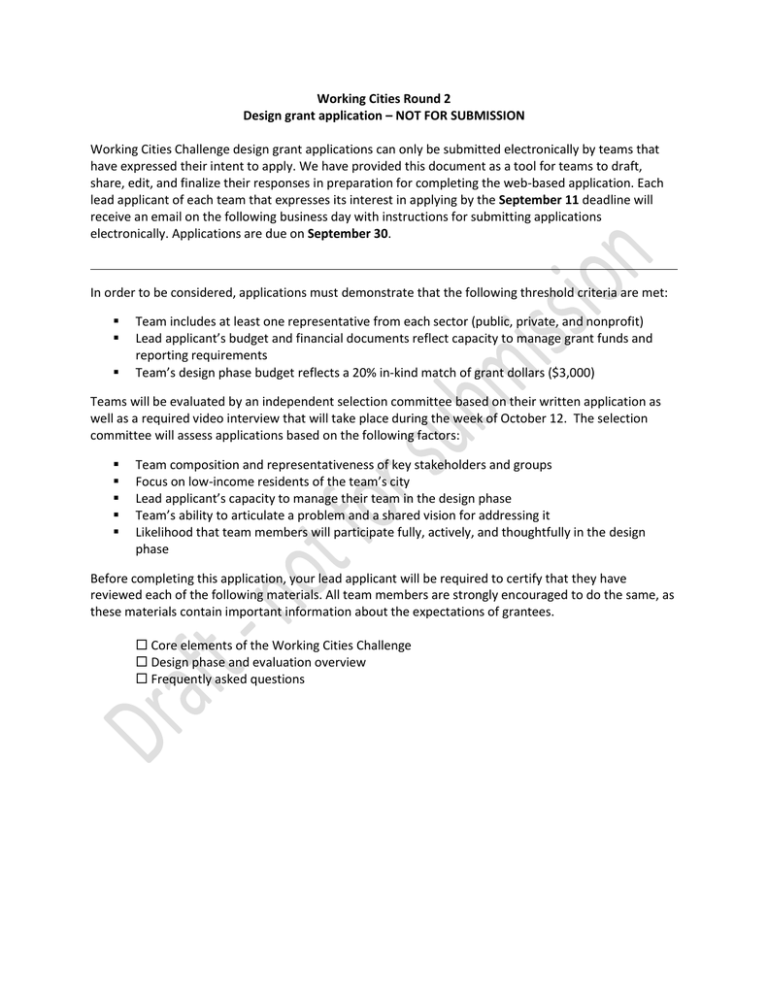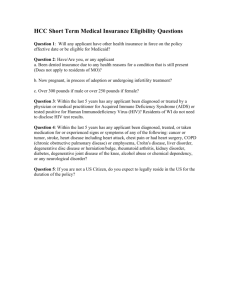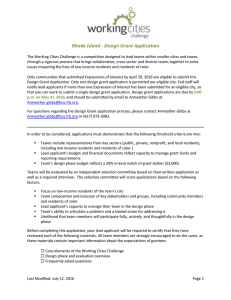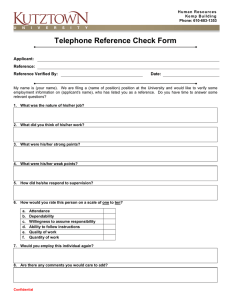Document 15626647
advertisement

Working Cities Round 2 Design grant application – NOT FOR SUBMISSION Working Cities Challenge design grant applications can only be submitted electronically by teams that have expressed their intent to apply. We have provided this document as a tool for teams to draft, share, edit, and finalize their responses in preparation for completing the web-based application. Each lead applicant of each team that expresses its interest in applying by the September 11 deadline will receive an email on the following business day with instructions for submitting applications electronically. Applications are due on September 30. In order to be considered, applications must demonstrate that the following threshold criteria are met: Team includes at least one representative from each sector (public, private, and nonprofit) Lead applicant’s budget and financial documents reflect capacity to manage grant funds and reporting requirements Team’s design phase budget reflects a 20% in-kind match of grant dollars ($3,000) Teams will be evaluated by an independent selection committee based on their written application as well as a required video interview that will take place during the week of October 12. The selection committee will assess applications based on the following factors: Team composition and representativeness of key stakeholders and groups Focus on low-income residents of the team’s city Lead applicant’s capacity to manage their team in the design phase Team’s ability to articulate a problem and a shared vision for addressing it Likelihood that team members will participate fully, actively, and thoughtfully in the design phase Before completing this application, your lead applicant will be required to certify that they have reviewed each of the following materials. All team members are strongly encouraged to do the same, as these materials contain important information about the expectations of grantees. Core elements of the Working Cities Challenge Design phase and evaluation overview Frequently asked questions Your cross-sector team 1. City: 2. In one sentence, what is the long-term vision that unites your team? (limit: 50 words) 3. Lead applicants will be responsible for managing your team’s work, communication, and budget during the design phase. They will also coordinate communication with and reporting to the Boston Fed during and after the grant period. The following information is designed to help us understand the lead applicant’s capacity to do this. Your team may elect to identify co-leads, in which case you must provide two responses. a. b. c. d. e. f. g. h. i. Organization name: Organization website: Primary contact name: Email: Phone: Number of staff: full time part time Organization’s mission statement (limit: 50 words): Operating budget for current fiscal year: List up to three competitive, collaborative grants you have received in the past three years, including funder, amount, and purpose (limit: 150 words): j. Please provide examples of collaborative planning processes you have managed and/or participated in (limit: 150 words): k. Be prepared to upload: 1) your most recent audited financial statement, 2) your most recent IRS Form 990 (for nonprofits), and 3) a list of your board members and their affiliations. l. m. n. o. p. q. r. s. t. (If your team is co-led) Organization name: Organization website: Primary contact name: Email: Phone: Number of staff: full time part time Organization’s mission statement (limit: 50 words): Operating budget for current fiscal year: List up to three competitive, collaborative grants you have received in the past three years, including funder, amount, and purpose (limit: 150 words): u. Please provide examples of collaborative planning processes you have managed and/or participated in (limit: 150 words): v. Be prepared to upload: 1) your most recent audited financial statement, 2) your most recent IRS Form 990 (for nonprofits), and 3) a list of your board members and their affiliations. The Working Cities Challenge is designed to support leaders working collaboratively across sectors, which Boston Fed research has found to be a necessary precondition for the resurgence of smaller industrial cities. In addition to having strong representation across sectors, teams can enhance the likelihood that their initiatives will succeed by engaging members of the community who will be directly impacted by this work in the development and implementation of their initiative. 4. Who are the core partners on your team (those that will be highly engaged in the process of designing your initiative)? Each of your core partners will be expected to participate fully in the design phase events facilitated by the Boston Fed as well as the planning you undertake in your own community. Core partners will also be required to participate in the evaluation of the design phase. For each member, provide: a. Name: b. Title, if applicable: c. Entity name, if applicable (organization/company/institution/agency/community group): d. If this partner represents an entity, please provide a brief description of that entity and/or provide a link to the entity’s website: e. Which sector(s) does this team member represent? Check all that apply: nonprofit organization volunteer civic, or social group public sector (e.g. municipal department, public schools, law enforcement, state agency) private business anchor institution (e.g. university, hospital) philanthropy city resident f. Issue area(s) of expertise: Economic development Financial stability Public safety Other: Education Health Transportation Environment Housing Workforce development g. Does this team member have any relevant affiliations with organizations/agencies/businesses/institutions in your city? If yes, please list. Examples include board membership, volunteerism, or serving as an elected or appointed official: Yes No If yes, list: Note: To complete this section of the draft application, you will need to copy and paste items 5ag for your additional team members. The electronic application will allow you to enter information for up to 12 partners. 5. What organizations, sectors, or perspectives are underrepresented or missing from your team, and how will you engage them during the design period? (limit: 200 words) 6. Have members of your team worked together in the past? If so, what have you done and what have you accomplished to date? If not, why did you decide to form a new partnership? (limit: 200 words) Your challenge The Working Cities Challenge is designed to help cross-sector teams work collaboratively to “move the needle” on key outcomes for cities and their low-income residents. In preparation for undertaking this work, please describe and quantify the problem you’ll be targeting through the WCC. 7. In one sentence, what is the problem your team wants to address through the Working Cities Challenge? (limit: 50 words) 8. What single measure best illustrates the scope of this problem in your city, and how has it changed over time? (limit: 50 words) Example: The share of Massachusetts children living in poverty is 16 percent. This proportion continues to climb from rates of 12 percent in 2002 and 13 percent in 2009. 9. How many people are affected by this problem across your city? You may use the additional space to describe how this problem affects key population subgroups (e.g. children, immigrants, residents of a particular neighborhood, residents with a certain level of education) if applicable. Total, across city: among among among (subgroup) (subgroup) (subgroup) 10. By focusing on this problem, what issue areas do you expect to address? Check all that apply. Economic development Financial stability Public safety Other: Education Health Transportation Environment Housing Workforce development Your approach The design phase is intended to help teams develop initiatives that will change systems (policies, procedures, resource flows, and decision-making processes) for the benefit of low-income residents. It will also include guidance and support in setting long-term goals and interim measures that will help you track your progress and course-correct as needed. Your answers to the following questions will help us determine the starting point for your team. We recognize that your answers are likely to change as you engage in this work more deeply. 11. What are the existing assets in your city that the team can build on to address this problem? Examples might include a complementary grant, a related planning process, or an organization or institution with experience or expertise in the area of focus. (limit: 200 words) 12. What is already going on in your city to address the problem? Please provide examples of investments, initiatives, policies, and/or plans that are relevant to your work. You may upload up to three supporting documents, such as newspaper articles, plans, studies, etc. (limit: 200 words) 13. The design phase is intended to help teams develop initiatives that will change systems (policies, procedures, resource flows, and decision-making processes) for the benefit of low-income residents. What strategies or activities is your team considering employing as part of its initiative? (limit: 200 words) 14. Imagine that your city’s newspaper is writing about the large-scale impact of your Working Cities Challenge effort 10 years from now. What will the headline say? (limit: 25 words) Design phase Reminder: please be sure to read the document detailing the design phase so that your team fully understands the process you will be invited to participate in should you receive a design grant. 15. What questions is your team most interested in exploring during the design phase, and what do you hope to learn through this process? (limit: 200 words) 16. In addition to participating in sessions convened by the Boston Fed, what activities does your team anticipate undertaking as part of the design phase? (limit: 200 words) 17. Budget: please use the template provided to describe how you expect to spend your design grant award. Your $15,000 grant can be used for costs associated with planning and developing your initiative, including staff time, consultants, event costs, and supply costs. You cannot use funds for capital expenditures or lobbying activities. Teams that demonstrate the need to make revisions will be given the opportunity to amend their budget during the design phase. Budgets must reflect a 20% in-kind match of the $15,000 grant award ($3,000). Expense description Total amount Amount(s) expended by partner Example: staff time $10,000 $5,000 – Agency X $5,000—Community group Y Note: you may add rows as needed to depict your complete draft budget.


